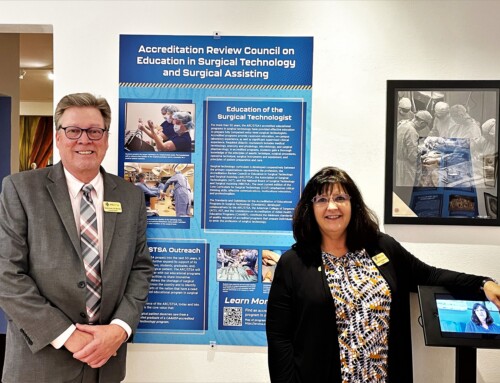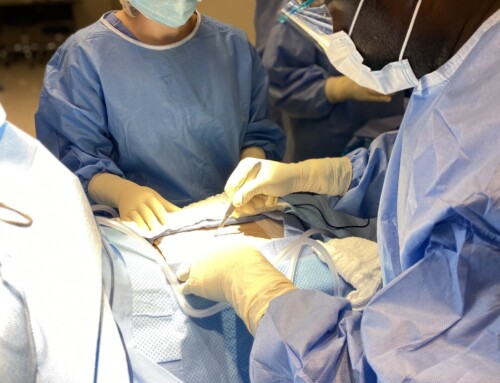
Featuring Dianna Mertz, CST, Parkview Hospital; Emily Russell, CST, The Orthopedic Hospital; and Terry Herring, Ed.S, CST/CSFA, CSPDT, CSIS, COA, surgical technology division chair at Fayetteville Technical Community College
Preceptors play a critical role in the OR, helping ensure students are set up for success while learning on the job. Before a student sets foot in the OR, however, educators must also do their part and serve as a conduit between student and preceptor. The relationship among these individuals requires thoughtfulness, clear communication and an understanding of expectations.
We spoke with two preceptors to learn how educators can help prepare their students for a positive partnership with preceptors, as well as ways preceptors can support students in the OR.
How Educators Can Support Preceptors
The relationship between educator and preceptor is a two-way street. While it’s the role of the preceptor to help students in the OR, educators can do a few things in advance to ensure a successful partnership with preceptors.
One of the first things an educator can do is get to know their preceptor. “Before students are brought to the facility, the educators should build a relationship with the preceptors,” explains Emily Russell, CST at The Orthopedic Hospital in Fort Wayne, Indiana. Think of it as an exercise in matchmaking. “You can see firsthand how they work with others and determine who would be a good fit for your student, rather than randomly placing a student in a room with a preceptor,” Russell says.
Back in the classroom, educators can set the right expectations for their students. “Teach your students to come prepared to help,” says Dianna Mertz, CST, at Parkview Hospital in Fort Wayne, Indiana. “We love it when students show initiative, ask questions, or help clean and change the room over.” She explains that a little proactivity can go a long way, as it shows the preceptor their interest and willingness to learn. Being a preceptor is an investment in time and energy. Seeing that passion reciprocated in a student makes the job that much more rewarding.
While a can-do attitude is welcome in the OR, it’s just as important for educators to emphasize good listening skills with their students. “Teach them to read the room. If we aren’t making small talk, there is usually a reason,” Mertz advises, noting students should be ready to adapt to a variety of environments. “Some surgeons like to talk, others don’t. Some will allow music in the room, others won’t.”
In addition to honing soft skills, preceptors also expect students will have general knowledge of instruments typically found in the OR. “When I was in school, we had a lab where we learned hands-on about the different set ups for each specialty,” Russell explains. “My instructors encouraged us to create a ‘Surgical Bible,’ a small picture book where we could have pictures of our set ups for each specialty, as well as notes about instruments and doctors’ preferences. The preceptors saw this and knew I was prepared before walking into their OR.”
The bottom line: preceptors need educators to be their partners in preparing students for learning in the OR. When the lines of communication are kept open, everyone wins.
You Don’t Know What You Don’t Know: Creating a Manual for Preceptors
When the surgical technology program at Fayetteville Technical Community College (FTCC) transitioned to an associate degree, senior students were required to take 96 credit hours in a chosen specialty, one-on-one with a preceptor. Because this was a brand new course, Terry Herring, Ed.S, CST/CSFA, CSPDT, CSIS, COA, surgical technology division chair at FTCC, created a preceptor manual. The document clearly outlines the mission of the program, expectations for the role, resources for working with students and more.
Included as well is an evaluation form for students to fill out regarding their preceptor, which Herring returns to the preceptor, keeping the lines of communication open.
The document is an opportunity to (literally) get everyone on the same page. Interested in viewing the manual for your own inspiration? Download a PDF copy here.
How Preceptors Can Support Students
It’s important for preceptors to remember that they, too, were once students learning the ins-and-outs of the OR. Russell’s advice is to be patient and keep at it — eventually students will begin to understand their role.
One way to ensure students are truly learning is through constructive feedback. “Let students know exactly what they are doing wrong and make sure you tell them the correct way of doing it,” Russell explains. Without filling that knowledge gap, a student is more likely to repeat the same mistakes.
But preceptors should be wary of just pointing out mistakes. It’s equally important to note positive things a student did during a case. “You can’t just tear them apart on stuff that they are doing wrong. You have to motivate them and let them know that they are doing a good job,” Russell says. Positive reinforcement, paired with constructive feedback, can be a powerful combination.
Creating an Environment Where Everyone Succeeds
In the long-run, when preceptors, educators and students work in partnership, the OR can become an environment everyone wants to work in each day. Thinking of preceptors, educators and students as a unit helps set everyone up for success and deliver on a surgical team’s ultimate goal: the safety of the patient.



